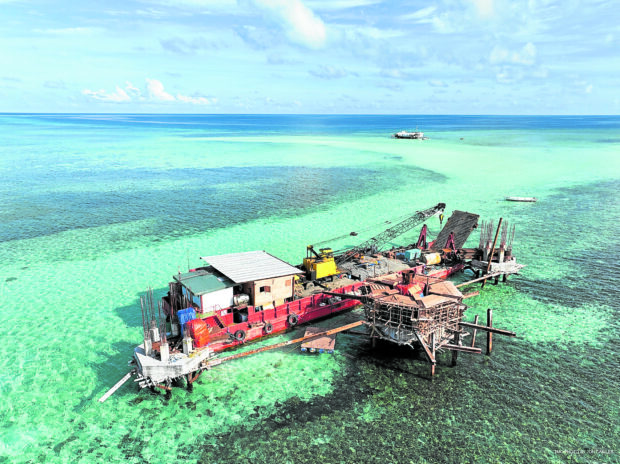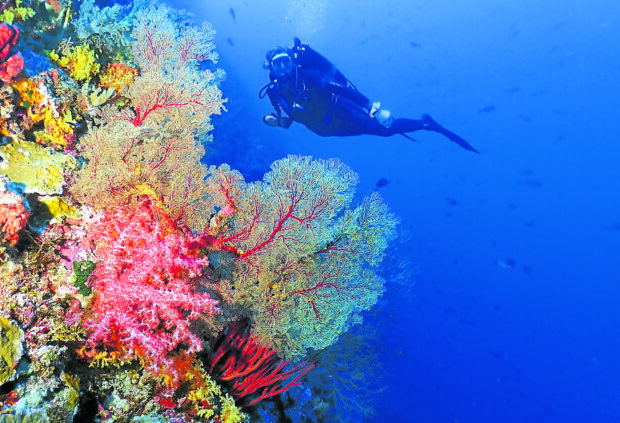
Like in any thriving ecosystem, the circle of life in the Tubbataha Reefs Natural Park, the Philippines’ premiere natural marine park in the middle of the Sulu Sea, is as clear as its waters on a beautiful summer’s day. Coral reefs may be damaged by weather and misguided vessels, but grow back with the slow passage of time; marine life ebbs and flows while remaining omnipresent; and the feathered visitors on Bird Islet, a major rookery for seabirds in the Asian region, fly through, lay eggs and may or may not return for the next season.
“Ngayon lang ako nakakita nang ganito kagrabe dito (It’s only now that I’ve seen something this bad),” says Joel Cos, hotel supervisor on board the Discovery Fleet dive boat, the M/Y Discovery Palawan (DP)—and the Puerto Galera native has seen a lot, having been with the company since 2007.
Cos is a familiar face to international guests of the boat, which can be found every Tubbataha season plying the waters of the 97,040-hectare marine protected area and United Nations Educational, Scientific and Cultural Organization World Heritage Site. Whether you want a martini, a second cup of coffee or an extra dive towel, Cos makes sure you get it.
Because of his years on the job, Cos knew about “80 percent” of the crew of the M/Y Dream Keeper, another Tubbataha-bound dive boat, which sank last April 30, smack in the middle of the brief dive season, when a strong squall hit the area. DP received a distress call from the Dream Keeper at about 15 minutes before 3 a.m., and was the first boat to respond to the call at that time; they obtained the coordinates, and proceeded to the site near Shark Airport at Tubbataha’s North Atoll between 3 a.m. and 3:30 am. When DP got there, Cos recounts, they couldn’t even see a boat anymore, no thanks to huge waves and pelting rain.With his friends in mind, Cos led several DP crew members to the site, on board their sturdy rubber dinghies, which took a while to get into the water because of the massive swells. He remembers seeing very little, until lightning illuminated the site. He saw a lifeboat filled with 10 people, about 15 more in life jackets hanging on to the side of the boat and another three swimming.
The DP crew were the first on-site to rescue survivors in the wet, dark night, first pulling out the people in the water before coming back to transfer those on the lifeboat. “Madaming umiiyak, parang hindi makapaniwala sa nangyari. Marami din may sugat. (Many were crying, like they couldn’t believe what happened. Many were also wounded.)”
As it turns out, several passengers had been hit by furniture, like the bar and tables, when the Dream Keeper listed. The timing was also providential; as recounted by the survivors, the boat had sunk completely in 20 to 30 minutes.

Meant to be there
On board DP, clothes and towels were provided to the drenched survivors. The chef proceeded to cook double the usual amount of food for everyone. Even guests gave clothes to those who escaped with nothing.
The DP crew made several more trips to the site, where they had left the Dream Keeper’s inflated life boat to mark the spot. By 7 a.m., the squall had died down completely.
By Cos’ account, they were meant to be there. DP’s departure from Puerto Princesa, take-off point for all dive trips to Tubbataha, had been delayed a day because of engine trouble. Had they been on schedule, DP would have been nowhere near the Dream Keeper, at a different site.
The survivors transferred to a Coast Guard vessel that arrived later in the day for the trip back to Puerto Princesa, and DP and a number of other dive boats who had responded to the call went on with their dive trips as scheduled. In a Facebook post in her “Mama Ranger’s Diaries” on May 8, Tubbataha’s protected area superintendent Angelique Songco, who was on board the Worldwide Fund for Nature (WWF) research boat M/Y Navorca with scientists doing fish and benthos research, gave credit where it was due:
“Discovery Fleet Corp.’s M/Y Discovery Palawan, first on the scene, undaunted by zero visibility, howling winds, a thunderstorm and pouring rain, deployed all its resources to save the passengers and crew of the Dream Keeper. The management of Discovery Palawan sheltered, clothed and fed the survivors. In a few moments, M/Y Almaroon Intrepid, P/Y Atlantis Azores, M/V Dolphin, M/Y Monsy, M/Y Palau Sport, S/Y Philippine Siren, M/Y Resolute, M/V Seadoors, M/V Solitude One, M/V Stella Mariz and M/Y Zamerdius were either on the scene or within radio contact, all their crews primed to assist in search and rescue (SAR) efforts. WWF-Philippines’ research vessel, M/Y Navorca and the marine park rangers on board two patrol boats also conducted search and rescue (SAR).
‘Kuya Joel’
“The Philippine Coast Guard vessel BRP Melchora Aquino (MRRV-9702) arrived as promptly as possible, relieving M/Y Discovery Palawan of its additional passengers. The Philippine Navy vessel PC375 arrived shortly to conduct SAR. The Western Command and Philippine Air Force provided critical support. The US Indo-Pacific Command was first to conduct airborne SAR starting in the afternoon of [April 30] and well into the night. It was flying over Tubbataha till past 10 p.m.”In total, according to the records of the Tubbataha Management Office (TMO), the Dream Keeper had 32 people on board, and 28 had been rescued: 15 crew members, 11 guests and two dive masters. Four people were never found: boat owner Denke “Jackie” Yang, 36; passengers Nino Anthony Labrador and Marianne Paz Labrador, both 36; and divemaster Timmy Jean “TJ” Bejoc, 32.
Cos was thinking in particular of TJ, who called him “Kuya Joel” and had worked on DP during the 2022 season. He even recalls how the crew had ended the season with TJ’s birthday party at a bar in Puerto Princesa, happily drinking and smearing birthday cake on each other’s faces.My friends and I had met TJ that 2022 season, a smiling young woman and mother of two. This year, the Palawan crew sported T-shirts printed with TJ’s picture underwater, which they sold to raise additional funds for her children.
I told Cos in Tubbataha last June that he and the crew had received a lot of praise for their efforts, but sitting in the dining deck of the boat, he simply looked into the distance at the deep blue sea. “Iniisip lang namin, mga kasama namin ‘yon. Mahalaga na masagip yung buhay ng mga tao. (We thought, those were our colleagues. It was important to save the lives of people.)”
“Bilib ka rin (You had to admire them),” Songco says, noting how many had pitched in to do their part during the tragedy. She would later receive messages inquiring about the safety of diving in Tubbataha and of the liveaboard boats. “I don’t know what it was like for dive operators, but I heard there were cancellations.
Home at sea
“There are violations that are done on purpose, and that’s what makes you angry,” she adds wistfully. “But something like this—nobody wants something like this to happen.”
She dwells instead on the goodwill that the tragedy generated on her FB post: “Is it because the catastrophes and calamities that plague us give us a lot of practice? Or is it thanks to our increased funding for disaster relief? I would like to believe it is because, above and beyond our differences and conflicts, we truly care for one another. Our shared empathy birthed a unified gathering of these kilometrically named agencies and people who were merely doing their jobs—but were also genuinely putting their hearts into saving others.”Meanwhile, with no disrespect to lives and property lost, life must go on in Tubbataha, with the lessons and losses feeding into the cycle to keep it going. The good news is that after 23 years, the Tubbataha Marine Park Rangers, composed of members of the Philippine Coast Guard and Philippine Navy, as well as personnel from the municipality of Cagayancillo and the TMO, may have a new home at sea, where they live on their 60-day tours of duty.
The construction began last May in the park’s North Atoll, after the Provincial Government of Palawan received the amount of P58,375,080 as money for the “rehabilitation of Tubbataha” on Oct. 25, 2022.
That was nine years after a US Navy ship ran aground in the park, and seven years after the United States paid the Philippine government for the damage. Mamsar Construction and Industrial Corp. has been contracted by the Provincial Government for the job.
“Depending on the availability of funds, we plan to complete the central structure, the research station, and the helipad,” says Songco. Estimated timeline was “10 years ago,” she says with a laugh, “but I cannot say when the funds will be available to complete the quarters of the rangers. Based on latest estimates, P74 million is still needed.” Cost for the three structures would reach P210 million, as one can imagine what it’s like to build in the middle of the sea.
There still is no set date for the move into the new 2,002-sq m structure, transferring from the dilapidated 702-sq m wooden and concrete station that was their home since 2000. Last Dec. 27, the old station was left empty for the first time in 23 years when the rangers were evacuated to Puerto Princesa after storms almost destroyed the structure. The heartwarming part was, the men wanted to return immediately. “They were so worried about what would happen to the reefs,” Songco recalls. “I told them their safety was more important.”
They returned in January after two weeks to rebuild the station, with help from the Metro Pacific Foundation Inc. The front porch that had been washed away was replaced, along with new wooden flooring and an extension for the living quarters, plus new furniture and fixtures. “We plan to use the old ranger station to store fuel and other supplies and materials,” Songco says.
The new digs are certainly well-deserved. More good news: The Tubbataha Marine Park Rangers have been nominated for the International Union for the Conservation of Nature World Commission on Protected Areas International Ranger Awards, created in 2020 to reward the hard work that rangers do in protected areas all over the globe. (The winners will be announced on July 26.)
Songco, also known as Mama Ranger, is praying that her “boys” will soon have more space in a home that is higher, more secure, and made of sturdier materials. “I hope one day, when there are strong winds and rain, I will no longer have to worry and wonder what’s happening in Tubbataha. I can sleep better.”

